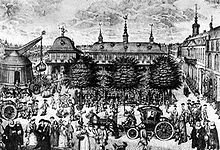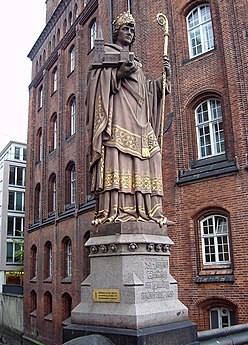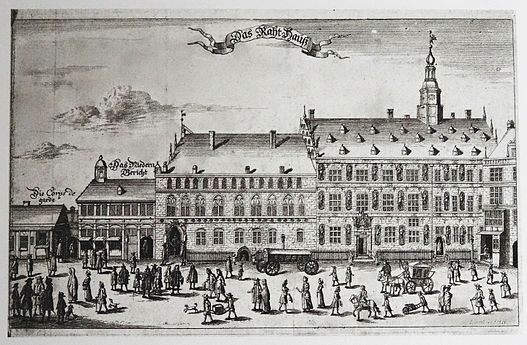Consolation Bridge
The Trostbrücke spans the Nikolaifleet in Hamburg . It originally connected the episcopal old town around the area of the cathedral and Petrikirche with the count's new town . From the Middle Ages to the Hamburg fire in 1842, this was the secular center of the city and the innermost part of the port. Both areas are now part of the Hamburg-Altstadt district .
history

The first bridge here is believed to have been built around 1200. The consolation bridge was first mentioned by name in 1266 (lat. Pons trostes). Your name may come from a crucifix on it, the consolation of Christianity (to be read on a memorial plaque attached in 1881). According to more recent sources, the name probably goes back to a landowner Consolation. Also in 1266 the bridge was called pons campsorum (changer bridge ), which suggests that money changers offered their business there. In 1480 the Trostbrücke is a meeting point for day laborers who wait there for employers. In 1686 the bridge was replaced by a stone bridge consisting of three arches, the middle of which is renewed after collapse in 1731. The bridge, which was repaired again in 1764–1765, was significantly damaged in the Hamburg fire in 1842 and was initially replaced by a temporary bridge. The current structure was built in 1881/82 according to plans by Franz Andreas Meyer . The porch at the eastern bridgehead was destroyed when the quay wall was redesigned.
The two statues on the bridge, created by Engelbert Peiffer , represent the areas it connects: Saint Ansgar, the founder of the cathedral and first archbishop of the city, stands for the old town, while Count Adolf III. zu Schauenburg, Stormarn and Holstein represents the secular Neustadt built by him.
Up until the great fire in the town in 1842, the old town hall , built in 1290, was located north of the Trostbrücke , which was extended several times by extensions until the 17th century until it was built over the canal . In addition to the lower court, it also housed the Hamburg bank . The House of the Patriotic Society now stands in its place .
South-east of the Trostbrücke, near the old stock exchange (in front of the current Commerzbank building ), the Hamburg stock exchange was founded in 1558, initially in the form of a fenced-in free space, guarded by stone lions. In 1578 a richly decorated half-timbered building was erected there by the wealthy dressmaker's guild by Jan Andresen from Amsterdam. The lower storey was a hall open to the side and was expanded on stilts above Nikolaifleet in 1666. The building was used until the move to the new stock exchange in 1841. Right next to it stood the city scales (rebuilt in 1669) with the statue of Justice, the “Great Crane” and the Schauenburg customs house. The building of the balance was from 1735 to 1841 seat of Commerzbibliothek and Commerz Deputation, today's Chamber of Commerce .
To the south-east is the Zollenbrücke , the oldest surviving canal bridge from 1633.
Adjacent buildings
Old Hamburg town hall on the Trostbrücke (copper engraving around 1690), destroyed in the great fire in 1842
The consolation bridge towards Laeiszhof
There are important historical buildings on the “Trostbrücke” street. They were built directly after the Hamburg fire or at the beginning of the 20th century in various historical architectural styles.
- 1. The Laeiszhof (Trostbrücke 1)
The Laeiszhof , southwest of the bridge, was built in 1897/98 as an office building for the F. Laeisz company according to plans by Bernhard Hanssen , Wilhelm Emil Meerwein and Martin Haller in the style of the Hanover School. By Bruno Kruse statues created provide Wilhelm I , Bismarck , Albrecht von Roon and Moltke . The person sitting on one of the gable Poodle figure refers to Sophie Laeisz that of her husband Carl Laeisz , the son of company founder Ferdinand Laeisz , poodle named has been.
- 2. The Globushof (Trostbrücke 2)
The Globushof is on the other side of the street. This building was built in 1907/08 by Lundt & Kallmorgen for Globus-Versicherungs AG, the last time the building housed offices of the Hamburg branch of Allianz-Versicherungen , which Globus took over. The building is currently being renovated.
- 3. The House of the Patriotic Society (Trostbrücke 4)
The house of the Patriotic Society at the Trostbrücke / Börsenbrücke stands on the place where the old Hamburg City Hall had been located since the 13th century until it was blown up during the Great Fire in 1842. After a competition in 1844, the building was built from 1845–1847 according to plans by Theodor Bülau .
Web links
- "Map of Hamburg 1868" with street search and interactive map
- Brief description on the website of the Hamburg State Office for Roads, Bridges and Waters
Individual evidence
- ↑ Braudel, Fernand. The trade - social history of the 15th – 18th centuries Century, Munich: Kindler, 1990. p. 47
- ↑ State Office Roads, Bridges and Waters, Hamburg Bridges in Portrait
- ↑ The Federal Minister of Transport (ed.), Steinbrücken in Deutschland , Beton-Verlag Düsseldorf, 1988, p. 202
- ^ Ralf Lange : Architecture in Hamburg. The great architecture guide . Hamburg 2008. ISBN 978-3-88506-586-9 , A 16
- ^ Ralf Lange, Architecture in Hamburg The great architecture guide . Hamburg 2008. ISBN 978-3-88506-586-9 , A 19
- ^ Ralf Lange, Architecture in Hamburg The great architecture guide . Hamburg 2008. ISBN 978-3-88506-586-9 , D 81
Coordinates: 53 ° 32 ′ 53 ″ N , 9 ° 59 ′ 32 ″ E







